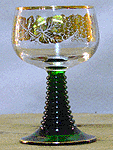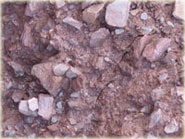German wine glossary
A B C D E F G H I J K L M N O P Q R S T U V W X Y Z
Rachis
The skeleton of branched stems which gives a grape bunch or cluster its shape. The rachis isn't obvious when covered with grapes, but very obvious after the grapes have been removed by mechanical harvesting. The mechanical harvester literally shakes the berries right off the vine, leaving the naked rachis still attached.
Racking
Decanting clear juice or wine from above the sediment in a tank. This is the easiest method for getting rid of solids which have settled to the bottom in a tank. Wine tanks commonly have a built-in "racking valve" placed about 20 inches (half a meter) above the bottom valve for use in racking wines during production.
Rebesorte
grape variety.
Reduced
Term describing an oxidation state which is the chemical opposite of oxidized. In wine, as in drinking water, the reduced state is usually recognized by the obvious smell of rotten eggs (hydrogen sulfide, or H2S).
Regent for a full list of grapes click HERE
(red grape) This grape is a cross between (Silvaner and Muller Thurgau) x Chambourcin originating from Siebeldingen it can give wines of quality and deep colour.
Regner for a full list of grapes click HERE
(red grape) Produced in Alzey in 1929 it is a cross between Luglienca Blanca and Gamay.
Reichensteiner for a full list of grapes click HERE
(white grape) created at Geisenheim in 1939 but not in general usage until 1978 it is a cross between Müller-Thurgau and (Madeline angevine X early Calabrese) it is similar to M ü ller-Thurgau but is less resistance to rot. There are about 250 ha planted.
Reinzuchthefen
Pure culture yeasts. Used by growers afraid of risk, hence stuck fermentations.
Residual sugar
Term commonly used in wine analysis referring to the content of unfermented sugar in a wine already bottled. Wine snobs take on a knowing look, lowering their eyes slightly, and call it "the R.S."
Restsüsse/Restzucher
Residual sugar
Respiration
The process whereby plants use oxygen to burn fuel (usually sugar) to create energy for their own growth, development and fruit production. These same reactions are used by animals except that animals take in oxygen through lungs, whereas plants absorb it through leaf pores and by diffusion of dissolved oxygen across membranes in leaves and roots, etc
Rhein
German spelling of Rhine, the well-known wine river which runs northward along Germany's western boundary.
Rheingau 
A beautiful wine region in Germany along an unusual portion of the Rhine river. Although the river runs generally northward, for a time it turns west, creating a slope on the north side of the river. On this slope facing southward towards the river is the Rheingau. The climate is greatly affected by the south facing slope, keeping the land warm in summer even though the Rheingau is one of the world's most northerly vineyards. The wines are as beautiful as the countryside, often considered to be (along with the great wines of Burgundy and Mosel) the finest white wines of the world.
For further information click for the rheingau page
Rheinhessen
Large wine province in western Germany which produces wines of the same name. It lies across the Rhine river and just upstream from the Rheingau, north of the Rheinpfalz (Palatinate).
For further information click for the Rheinhessen page
Rhine
Famous wine river in Germany. Name given to all German wines produced from vineyards near the Rhine river.
Rhinewines
Any of the group of wines grown in regions along the Rhine river. These include Rheingau, Rheinhessen, Mittelrhein and Palatinate (or Pfalz).
Rhone
Major river in southeastern France, flowing from Switzerland to the Mediterranean. Name given to the wines produced from vineyards along that river.
Rieslander for a full list of grapes click HERE
(white grape) This is a Silvaner X Riesling cross from Würzburg in1921 it is very useful for producing the noble sweet wines of ba and TBA Has two synonym names - Mainriesling and Wuerzburg.
Riesling for a full list of grapes click HERE
(aka Riesling in Germany and Rheinriesling in Austria). A white-wine variety widely grown along the Rhine river and tributaries - (e.g.: Rheingau, Rheinhessen, Mosel, Nahe regions etc.) Where it can produce a flowery, fruity dry wine with high acid and low alcohol the "Kabinett” or a semi-dry style with some residual sugar the "Spätlese”. If infected with appropriate amounts of "botrytis", it can make outstanding late-harvest wines Riesling enjoys a worldwide reputation as the king of white wines. In the Ortenau district of Baden it is called Klingelberger. It is the latest ripening of all variety grape varieties. Therefore, it can only be grown in the very best vineyards. Baden Riesling expresses a very typical regional character; it is racy, with fruity acid and has a highly refined nose.22, 000 ha are planted making it the most widely planted Grape in Germany. There are many clones of the Riesling and some have been very high yielding, but now lower copping higher quality vines are being planted. The Riesling is one of the best white grape varieties in the world if not the very best.
Rivaner for a full list of grapes click HERE
(white grape) see Müller Thurgau.
Römer or Roemer

Traditional German drinking-glass with ovoid bowl, cylindrical stem (decorated with applied prunts) and spreading spirally-trailed foot. Name possibly from Lower Rhenish römen (to boast). Thought by some to be the origin of the English word rummer.
Rose
(pronounced row-zeh') French word for pink table wine, now commonly used all over the world.
Rotling - Rose.
Rotwein - Red wine
Rotberger for a full list of grapes click HERE
(red grape) A cross between Trollinger and Riesling from Geisenheim. Often used for rose and sparkling wine. Has synonym name Geisenheim 3-37.
Rotliegendes
reddish slate.
Ritgipfler
Austrian white-wine grape blended with Spätrot grape wine to give a superior zesty, intensely fruity wine
Rougeau
Leaf reddening, caused by any of several viruses in grapevines. The virus infection seals off the leaf petiole (stem) so that the sugars produced by the leaf through photosynthesis cannot be transported back into the vine. The sugar accumulates there until the leaf, in an effort to get rid of a problem, uses it to make red anthocyanin pigment. Vines infected by these viruses have difficulty in ripening their fruit because much of the sugar the vine produces cannot be used by the vine where it needs it -- in the fruit. Leafroll virus is a common example of this type of infection.
Rough
Tasting term to indicate a wine, usually red, with too much tannin making it difficult to enjoy. Rough wines sometimes age well, becoming softer and well balanced wines after a few years.
Rulander
Synonym for Pinot Gris, Pinot Grigio, or Grauerburgunder. This is a white wine grape which has just enough colour in the skins to make the appearance not yellow or green, but grey. It is grown in Germany, Alsace, Italy, Switzerland and in several places in the new world. Makes a nice wine under the right conditions.
Wine villages beginning with 
click the village name for a list of its einzellagen (individual vineyards)






